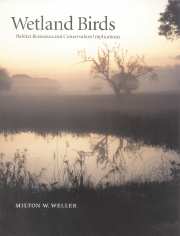Book contents
- Frontmatter
- Contents
- List of plates
- Preface
- Acknowledgments
- 1 Introduction
- 2 Wetlands: what, where, and why
- 3 Major groups of birds that use wetlands
- 4 Water and other resource influences
- 5 Foods, feeding tactics, strategies, and guilds
- 6 Bird mobility and wetland predictability
- 7 Other behavioral and physical influences on wetland living
- 8 Spatial and structural patterns
- 9 Habitat dynamics: water, plant succession, and time
- 10 Population consequences of wetland abundance and quality
- 11 How birds influence wetlands
- 12 Conservation implications
- 13 Measures of bird habitat use and quality
- 14 Current status and some conservation problems
- 15 Conservation and management strategies
- 16 Outlook
- 17 Epilogue
- Appendix 1 Scientific names of birds and bird groups
- Appendix 2 Scientific names of animals and animal groups other than birds
- Appendix 3 Scientific names of plants and plant groups
- Index of birds and bird groups
- Subject index
5 - Foods, feeding tactics, strategies, and guilds
Published online by Cambridge University Press: 02 October 2009
- Frontmatter
- Contents
- List of plates
- Preface
- Acknowledgments
- 1 Introduction
- 2 Wetlands: what, where, and why
- 3 Major groups of birds that use wetlands
- 4 Water and other resource influences
- 5 Foods, feeding tactics, strategies, and guilds
- 6 Bird mobility and wetland predictability
- 7 Other behavioral and physical influences on wetland living
- 8 Spatial and structural patterns
- 9 Habitat dynamics: water, plant succession, and time
- 10 Population consequences of wetland abundance and quality
- 11 How birds influence wetlands
- 12 Conservation implications
- 13 Measures of bird habitat use and quality
- 14 Current status and some conservation problems
- 15 Conservation and management strategies
- 16 Outlook
- 17 Epilogue
- Appendix 1 Scientific names of birds and bird groups
- Appendix 2 Scientific names of animals and animal groups other than birds
- Appendix 3 Scientific names of plants and plant groups
- Index of birds and bird groups
- Subject index
Summary
Food resources within wetlands can be diverse and vary temporally and spatially. Birds are unique among vertebrates in their ability to use wetlands dispersed over hundreds or thousands of miles in their annual range. However, they are most restricted in movement during the nesting and rearing season or when they are flightless owing to age or annual wing molt. In addition to flight, they may have the flexibility of swimming, running, or walking as needed and efficient, and this reflects the end-products of long years of trial and error. This should not infer that all wetland birds are wandering long distances in search of food, but that they could and sometimes do. Typically, they are bound by a series of historical and evolutionary events that have resulted in the development of successful patterns of movement and breeding strategies for a given region, which is intimately tied to food resources.
Finding accurate information on foods used by birds seasonally and at various life-cycle stages and ages is difficult. An old but still valuable summary of food use by birds in North America is Martin, Zimm and Nelson (1951), but this and papers of this period contain some errors resulting from the examination of gizzards rather than esophagi alone for some bird groups. This underestimates soft animal matter and exaggerates hard seeds. More available but less quantitative summaries of general food uses are in Erlich, Dobkin and Wheye (1988) and Kaufman (1996) in the USA and in similar treaments of bird life histories in each region or country. In addition, there are numerous detailed studies of selected species; however review papers for various taxa, where they exist, are the best source.
- Type
- Chapter
- Information
- Wetland BirdsHabitat Resources and Conservation Implications, pp. 63 - 82Publisher: Cambridge University PressPrint publication year: 1999



